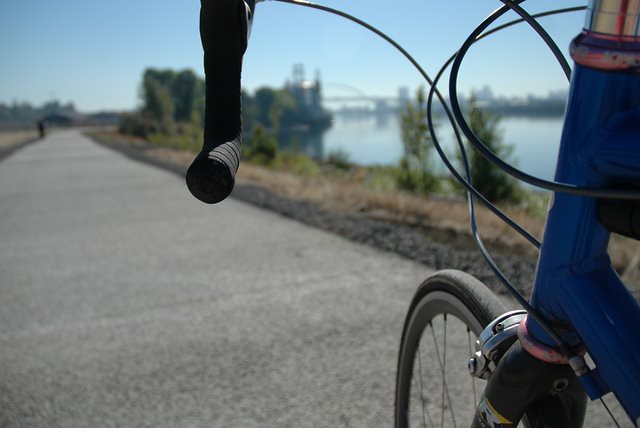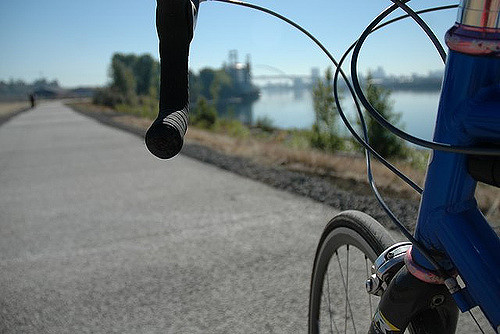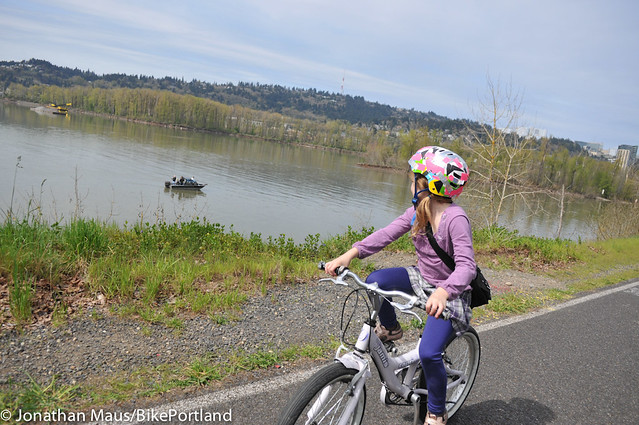
(Photos: J.Maus/BikePortland)
The Portland Bureau of Parks and Recreation is rarely discussed as part of the answer to Portland’s transportation problems.
Instead of relying mostly on relatively costly off-street paths, which are the main channels for low-stress bike transportation in most of the United States, Portland generally prides itself on improving its actual streets for biking.
But the city’s parks bureau is currently facing a problem that many transportation advocates don’t know about: How to spend the tens of millions of dollars in fees from new development that have been pouring into city coffers for years now.
To be clear, the parks bureau has a very long wish list, worth $1.2 billion over the next 20 years. More biking and walking paths are only part of it.
But a number of potentially major biking corridors — the Red Electric Trail and Willamette Greenway Trail in the southwest, Sullivan’s Gulch Trail in the northeast, the North Portland Greenway in the north — have been envisioned for years and are mostly just awaiting cash.
It’s cash that the parks bureau, increasingly, might be able to start spending.

System development charges, the fees paid to the city by developers of new buildings, will rise sharply on July 1. In March, a city budget report showed that SDCs have already been arriving at the city faster than it’s been spending them, piling up to a $42 million stash by last summer. During fiscal year than ends June 30, the city is expected to have collected $20 million more.
Compare those figures to the $1.4 million per year that the city’s new gas tax will dedicate to protected bike lanes and neighborhood greenways, and you begin to get a sense of how much difference a bit of parks funding could make for transportation.
Advertisement
Here’s a list of $55 million in possible work on the four trails mentioned above, all of it 100 percent eligible for system development charge money and 95 percent of it allocated to be spent in the early 2020s, if the city council ever decided to add it to the bureau’s to-do list.
New parks and trails would also increase the city’s operating expenses
Though a surplus of money for constructing and improving parkland is obviously a good problem for Portland to have, it does come with complications — for example, the need for the operating funds that keep new parkland clean and safe.
System development charges can’t be spent on mowing crews or park rangers, for example; property taxes and other revenue would be needed for that. This is from the city budget report:
The expansion of parks services will necessarily require a shift of General Fund resources away from other City priorities, such as public safety and housing, in order to fund the operations and maintenance of new park facilities. The City needs to take into account the negative impact of reducing these other services – along with the equity impact this may have on specific communities – when making decisions about expanding Parks’ services.
And this:
Council’s recent direction to no longer enforce camping restrictions on public spaces has caused an increase in the need for ranger services in parks across the city, but particularly along the Springwater Corridor Trail. Rangers receive some training in working with homeless individuals and referring them to appropriate service providers; however, CBO notes that to the degree other solutions in the FY 2016-17 budget alleviate the number of individuals camping in parks, the demand for this type of ranger service may be lessened. Second, due to staffing constraints in the Police Bureau, there has been a decrease in patrolling and community policing, which have increased reliance on Park Rangers to provide response to non-urgent park incidents. Whereas some safety concerns were previously being addressed by police officers, rangers now address these situations or the situations are not addressed.
All public space requires operating costs. For cities, the question is whether it can deliver value to justify those costs.
Most Portlanders like parks; a 2014 property tax ballot measure to repair old ones won by a 43 point margin. And most Portlanders like bicycling, too, both transportation and recreation. Combining two values together to find the common links, though, would require politics.
— Michael Andersen, (503) 333-7824 – michael@bikeportland.org
Our work is supported by subscribers. Please become one today.




